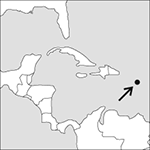
Capital:
Saint John’s
Area:
441.6 sq km (170.5 sq miles)
Population:
89,018 (2012 est)
Currency:
1 East Caribbean dollar = 100 cents
Religions:
Anglican 25.7%; other Protestant (mainly Moravian, Methodist, Pentecostal, and Seventh‐day Adventist) 50.7%; Roman Catholic 10.4%; other Christian 5.4%
Ethnic Groups:
Black 91.0%; Mixed 4.4%
Languages:
English (official); English creole
International Organizations:
UN; Commonwealth; CARICOM; OAS; WTO; Non‐Aligned Movement
A country in the Leeward Island group of the Caribbean, comprising the islands of Antigua, Barbuda, and Redonda (uninhabited).
Physical
The main island, Antigua, comprises 280 sq km (108 sq miles) of fairly bare scrubland. Formed of volcanic rock in the south‐west and coral in the north and east, it is moderately hilly, rising to 405 m (1329 feet). The coastline is indented. Water is scarce.
Economy
The mainstay of the economy is upmarket tourism. Manufacturing industry includes bedding, handicrafts, and the assembly of electrical components for re‐export. There is little agriculture.
History
Antigua and Barbuda were colonized from the 17th century by the British, who brought slaves from Africa to work on the islands. From 1871 until 1956 the islands were part of the British colony of the Leeward Islands. Antigua and Barbuda joined the West Indian Federation, and in 1967 became an Associated State of Britain, gaining internal autonomy. The country became fully independent in 1981. The Antiguan Labour Party (ALP) held power from 1976 until 2004, when it was defeated in a general election by the United Progressive Party (UPP). The UPP was re-elected in 2009. However, the impact of the world recession and the collapse of Antiguan-based Stanford banking empire made the government unpopular, and the ALP were returned with a large majority in the 2014 elections.
- carrier frequency
- carrier gas
- carrier mobility
- carrier molecule
- carrier recombination
- carrier sense multiple access collision avoidance
- carrier storage
- carrier transmission
- carrier wave
- Carrington heliographic coordinates
- Carrington, Richard Christopher (1826–75)
- Carrington rotation
- Carroll, Lewis
- carry forward losses
- carrying capacity
- carry lookahead
- carry-over effect
- carry trade
- Carr–Purcell–Meiboom–Gill sequence
- CARS
- Carson, Edward Henry, Baron (1854–1935)
- Carson, Kit (1809–68)
- CART
- Cartan, Elie Joseph
- Carte du Ciel